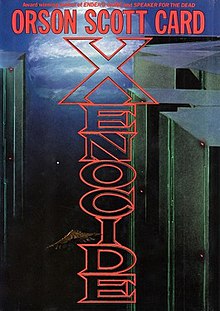This article has multiple issues. Please help improve it or discuss these issues on the talk page. (Learn how and when to remove these messages)
|
 Cover of first edition (hardcover) Cover of first edition (hardcover) | |
| Author | Orson Scott Card |
|---|---|
| Cover artist | John Harris |
| Language | English |
| Series | Ender's Game series |
| Genre | Science fiction |
| Published | 1991 (Legend), 1992 (Tor Books) |
| Publication place | United States |
| Media type | Print (Hardcover, Paperback & ebook) |
| Pages | 592 |
| Dewey Decimal | 813/.54 20 |
| LC Class | PS3553.A655 X46 1991 |
| Preceded by | Speaker for the Dead |
| Followed by | Children of the Mind |
Xenocide (first published in 1991) is the third book in the Ender's Game series, a science fiction series by the American author Orson Scott Card. It was first published during a period of increasing globalization and heightened awareness of cultural differences, and the writing reflects this in its techniques, mood, and emotive effect on the reader. Xenocide explores themes of communication, xenophobia, and the potential dangers of advanced technology.
Xenocide was nominated for both the Hugo Award and Locus Awards for Best Novel in 1992.
Background
Card incorporated elements from his earlier publication, Gloriously Bright, from the January 1991 issue of Analog Science Fiction and Fact, into the novel.
Xenocide refers to the "killing or attempted killing of an entire alien species."
'Xeno-' comes from the Greek word for "stranger, foreigner, or host;"
'-cide' is a word-forming element meaning "killing." From French -cide and Latin -cidium meaning "a cutting, a killing."
Plot summary
This section has multiple issues. Please help improve it or discuss these issues on the talk page. (Learn how and when to remove these messages)
|
| A book-length plot description (an additional 1800 words, 11,578 characters) |
|---|
LusitaniaFollowing the events of Speaker for the Dead, the novel portrays a complex ecosystem on Lusitania inhabited by humans, the small, pig-like Pequeninos, and the Hive Queen. This fragile peace is threatened by the Descolada virus, a crucial element in the Pequeninos' life cycle but lethal to humans. The Starways Congress's decision to destroy Lusitania to prevent the virus's spread highlights the central conflict of the novel: the potential for fear and misunderstanding to lead to drastic and irreversible actions. This echoes historical examples of environmental degradation and species extinction resulting from human activities, prompting contemplation on the ethical ramifications of prioritizing human safety over the conservation of other living forms. The growing environmental movement of the late 20th century, with its emphasis on biodiversity and ecological interconnectedness, provides a relevant context for understanding the novel's exploration of these themes. The concept of interconnected ecosystems gained prominence during this period, influencing scientific understanding and public awareness of environmental issues.
(Remainder of plot summary omitted for brevity, as instructed) |
Reception
Xenocide received recognition in the science fiction community with nominations for the Hugo Award and the Locus Award for Best Novel in 1992.
The New York Times Book Review offered a mixed assessment of Xenocide in 1991. The review recognized the novel's ambitious philosophical themes but also criticized its pacing and dialogue, suggesting that the complex ideas could have been more impactful in a more concise format.
See also
References
- Harris, John. Illustrator. Xenocide. By Orson Scott Card. Tor, 1991.
- ^ "The New York Times: Book Review Search Article". archive.nytimes.com. Retrieved August 6, 2024.
- ^ WWE Staff (July 21, 2024). "1992 Award Winners & Nominees". Worlds Without End. Tres Barbas, LLC. Archived from the original on August 14, 2009. Retrieved July 15, 2009.
- Prucher, Jeff (2024) . "Xenocide". The Oxford Dictionary of Science Fiction. Oxford, England: Oxford University Press. doi:10.1093/acref/9780195305678.001.0001. ISBN 9780199891405. Retrieved July 21, 2024.
- Harper, Douglas & Etymonline Staff (2024). "xeno-". Etymology Online. Retrieved July 21, 2024.
- OED Staff (2024). "xeno-". OED.com. Oxford, England: Oxford University Press. Retrieved July 21, 2024.
- Harper, Douglas & Etymonline Staff (2024). "-cide". Etymology Online. Retrieved July 21, 2024.
- OED Staff (2024). "-cide". OED.com. Oxford, England: Oxford University Press. Retrieved July 21, 2024.
External links
- About the novel Xenocide from Card's website Archived May 18, 2008, at the Wayback Machine
- Xenocide title listing at the Internet Speculative Fiction Database
| Works by Orson Scott Card | |||||||||||||||||||||
|---|---|---|---|---|---|---|---|---|---|---|---|---|---|---|---|---|---|---|---|---|---|
| |||||||||||||||||||||
| |||||||||||||||||||||
| |||||||||||||||||||||
| |||||||||||||||||||||